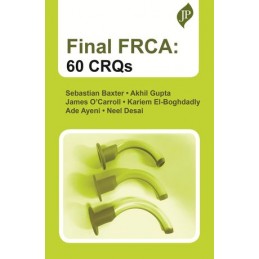- Reduced price

Order to parcel locker

easy pay


 Delivery policy
Delivery policy
Choose Paczkomat Inpost, Orlen Paczka, DHL, DPD or Poczta Polska. Click for more details
 Security policy
Security policy
Pay with a quick bank transfer, payment card or cash on delivery. Click for more details
 Return policy
Return policy
If you are a consumer, you can return the goods within 14 days. Click for more details
This book is a practical revision aid for postgraduates preparing for Final FRCA (Fellowship of the Royal College of Anaesthetists) written examinations.
Presented in the style of the newly introduced CRQ (Constructed Response Questions) format, the book features five complete papers, each containing twelve questions. Topics cover the entire examination syllabus.
Detailed answers are given for every question, as well as comprehensive references for further reading.
Key points
Data sheet
PAPER 1
1.1 Inotropes and management of cardiogenic shock
1.2 Subarachnoid haemorrhage
1.3 Ventilator-associated pneumonia
1.4 Postdural puncture headache
1.5 Neonatal/Ex-premature infant anaesthesia
1.6 Chronic, neuropathic pain and complex regional pain syndrome
1.7 Chemotherapy, obesity and renal transplantation
1.8 Local anaesthetic systemic toxicity
1.9 Penetrating eye injury
1.10 Endovascular aneurysm repair
1.11 Anatomy and nerve injuries
1.12 Fibreoptics and neurological monitoring
PAPER 2
2.1 Aortic stenosis, pacing and antibiotics
2.2 Myotonic dystrophy
2.3 Delirium in the intensive care unit
2.4 Major obstetric haemorrhage
2.5 Child protection
2.6 Assessment and management of pain in special groups
2.7 Malignant hyperthermia
2.8 Awake tracheal intubation
2.9 Problems in non-theatre locations and transcatheter aortic valve implantation
2.10 Lower limb regional anaesthesia
2.11 Deep sedation and safe sedation techniques
2.12 Transfer definitions and transfer by air
PAPER 3
3.1 Management of cardiopulmonary bypass and haemorrhage
3.2 Spinal cord anatomy and pathology
3.3 Nutrition in the critical care unit
3.4 Obesity in pregnancy and uterine inversion
3.5 Paediatric sepsis/advanced paediatric life support
3.6 Pain, its measurement and modulation
3.7 Phaeochromocytoma
3.8 Tracheostomy
3.9 Electroconvulsive therapy
3.10 Knee arthroplasty/enhanced recovery after surgery
3.11 Day surgery:: Guidelines and suitability
3.12 Intravenous fluids and goal-directed therapy
PAPER 4
4.1 Thoracic anaesthesia, pneumothorax and one-lung ventilation
4.2 Pituitary gland and surgery
4.3 Acute kidney injury and renal replacement therapy
4.4 Multiple pregnancy and amniotic fluid embolism
4.5 Pyloric stenosis
4.6 Cancer pain
4.7 Oesophagectomy
4.8 Arrests postcardiac surgery, resternotomy, pacing
4.9 Scoliosis surgery and blood conservation
4.10 Major traumatic haemorrhage, scoring systems
4.11 Cataract surgery
4.12 Design of a randomised controlled trial
PAPER 5
5.1 Perioperative management of patients for cardiac surgery and off pump surgery
5.2 Parkinsons disease
5.3 Intensive care unit acquired weakness
5.4 Placenta praevia, premature labour and failed intubation
5.5 Paediatric day surgery
5.6 Chronic face pain
5.7 Anaphylaxis
5.8 Arrests in prone position, post-arrest cooling and prognostication
5.9 Upper limb regional anaesthesia
5.10 Drowning and hypothermia
5.11 Abdominal aortic aneurysm rupture
5.12 Airway management in burns and fluid resuscitation
Reference: 10859
Author: Piotr Karniej
Praktyczne wskazówki dla kadry zarządzającej
Reference: 102643
Author: David E. Fisher
Reference: 71703
Author: Robb Rehberg
